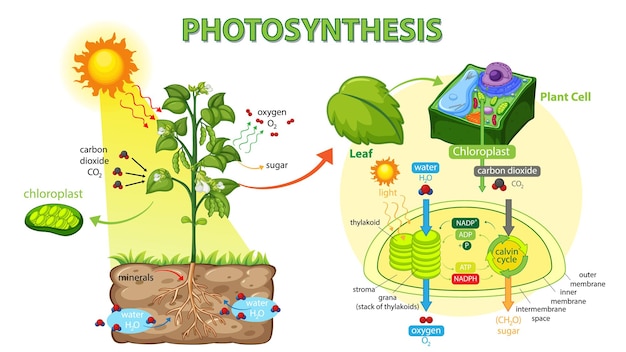Interesting Facts About Photosynthesis

Photosynthesis is the process by which plants convert sunlight into energy.
Chlorophyll is the green pigment found in plant leaves responsible for capturing sunlight.
Photosynthesis, in essence, is the reason why life on Earth exists.
During photosynthesis, plants release oxygen that is vital for humans and animals.
Photosynthesis is a delicate balance of chemical reactions that take place within plant cells.
Sunlight is the key ingredient for photosynthesis to occur.
Photosynthesis occurs in the chloroplasts of plant cells.
Plants convert carbon dioxide and water into glucose and oxygen through photosynthesis.
Without photosynthesis, plant life as we know it would cease to exist.
Photosynthesis is the reason why plants can grow and thrive in different environments.
The word photosynthesis comes from the Greek words photo, meaning light, and synthesis, meaning to put together.
Photosynthesis is most efficient in blue and red light wavelengths.
Light intensity and temperature play a crucial role in the rate of photosynthesis.
Photosynthesis is a complex process that involves multiple chemical reactions.
Photosynthesis is divided into two stages: the light-dependent reactions and the light-independent reactions (Calvin cycle).
The byproduct of the light-dependent reactions is oxygen.
Photosynthesis can be disrupted by pollution and environmental factors.
C4 plants have a unique adaptation to enhance the efficiency of photosynthesis in hot and dry environments.
Interesting Facts About Photosynthesis part 2
Photosynthesis not only sustains plant life but also forms the basis of many food chains and ecosystems.
Algae and some bacteria also undergo photosynthesis.
Photosynthesis helps regulate the Earth’s carbon dioxide levels.
Ancient cyanobacteria were the first organisms to perform photosynthesis.
The process of photosynthesis was first discovered and understood by Jan Ingenhousz in the late 18th century.
Plants absorb visible light through pigments like chlorophyll a, chlorophyll b, and carotenoids.
Photosynthesis is an essential part of the carbon cycle.
Photosynthesis enables the growth and development of leaves, stems, and roots in plants.
Plants can adjust the rate of photosynthesis to respond to environmental conditions.
Photosynthesis is a biochemical reaction that converts light energy into chemical energy.
The glucose produced during photosynthesis is stored for future energy use by the plant.
Photosynthesis helps in the production of biofuels and renewable energy sources.
Some plants, like orchids and algae, can perform photosynthesis in low light conditions.
The first step of photosynthesis is the absorption of light energy by chlorophyll molecules.
The energy captured during photosynthesis is stored in the form of chemical bonds.
Photosynthesis is an important factor in reducing global warming by removing carbon dioxide from the atmosphere.
The rate of photosynthesis increases with an increase in carbon dioxide concentration, up to a certain threshold.
Photosynthesis is a process that takes place in the leaves since they have the most chloroplasts.
Water is crucial for photosynthesis, as it provides the hydrogen atoms necessary for glucose synthesis.
The oxygen released during photosynthesis comes from the splitting of water molecules.
Photosynthetic organisms can adapt to changes in light intensity by adjusting the size and number of their chloroplasts.
Sunflowers are known for their high photosynthetic efficiency.
Some plants, such as succulents, have adapted to low-water environments by performing crassulacean acid metabolism (CAM) photosynthesis.
Photosynthesis is responsible for the brilliant colors seen in autumn leaves.
The discovery of photosynthesis revolutionized our understanding of how plants grow and thrive.
Photosynthesis produces an estimated 160 billion tons of glucose across the Earth each year.
Photosynthesis is not only vital for plant life but also plays a role in shaping the Earth’s atmosphere and climate.

